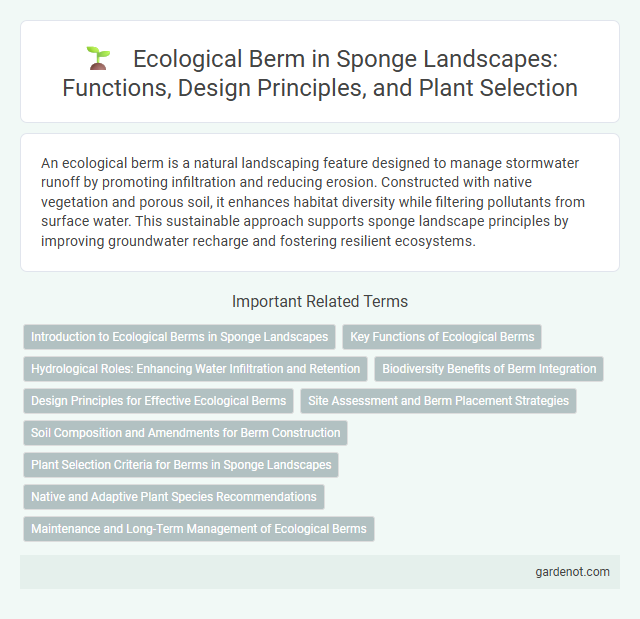An ecological berm is a natural landscaping feature designed to manage stormwater runoff by promoting infiltration and reducing erosion. Constructed with native vegetation and porous soil, it enhances habitat diversity while filtering pollutants from surface water. This sustainable approach supports sponge landscape principles by improving groundwater recharge and fostering resilient ecosystems.
Introduction to Ecological Berms in Sponge Landscapes
Ecological berms in sponge landscapes serve as natural barriers designed to manage water runoff and enhance infiltration, reducing flood risks and improving groundwater recharge. These berms are constructed using native vegetation and permeable materials that promote biodiversity while stabilizing soil and filtering pollutants. Integrating ecological berms into sponge landscape planning supports sustainable urban drainage and resilience against climate change impacts.
Key Functions of Ecological Berms
Ecological berms serve as natural barriers that control stormwater runoff, reduce soil erosion, and enhance groundwater recharge by slowing water flow and increasing infiltration. These structures create habitat diversity by supporting native vegetation, which improves biodiversity and fosters pollinator activity. By stabilizing slopes and filtering pollutants, ecological berms contribute to improved water quality and resilient sponge landscapes.
Hydrological Roles: Enhancing Water Infiltration and Retention
Ecological berms play a crucial role in sponge landscapes by enhancing water infiltration and retention, which helps reduce surface runoff and mitigates soil erosion. These structures improve groundwater recharge and maintain soil moisture levels critical for plant growth and ecosystem stability. By slowing down water flow, ecological berms support natural filtration processes, promoting healthier watershed management.
Biodiversity Benefits of Berm Integration
Ecological berms enhance sponge landscapes by providing diverse habitats that support a wide range of flora and fauna, increasing local biodiversity. These structures promote soil stabilization and water infiltration, creating microenvironments that benefit pollinators, amphibians, and native plant species. Integrating berms into sponge landscapes fosters resilient ecosystems, improving ecological connectivity and natural water management.
Design Principles for Effective Ecological Berms
Ecological berms optimize stormwater management by incorporating native vegetation, soil permeability, and graded slopes to enhance water retention and filtration. Design principles emphasize integrating diverse plant species that support local biodiversity while stabilizing soil and reducing erosion. Effective berms balance hydraulic functions with ecological benefits, ensuring long-term resilience and habitat connectivity within sponge landscapes.
Site Assessment and Berm Placement Strategies
Ecological berm design begins with comprehensive site assessment, analyzing topography, soil properties, hydrology, and native vegetation to determine optimal berm placement. Effective berm placement strategies prioritize natural water flow patterns to intercept runoff, enhance infiltration, and prevent erosion while supporting local biodiversity. Strategic positioning on slopes or flood-prone areas maximizes ecological benefits, stabilizing soil and improving water quality through biofiltration processes.
Soil Composition and Amendments for Berm Construction
Ecological berm construction relies heavily on optimized soil composition, combining sandy loam with organic matter such as compost and biochar to enhance water retention and nutrient availability. Amendments like mycorrhizal fungi and earthworm castings improve soil structure, fostering microbial activity essential for plant root development and erosion control. This tailored soil matrix supports the sponge landscape's function by maximizing infiltration and promoting native vegetation growth.
Plant Selection Criteria for Berms in Sponge Landscapes
Plant selection for ecological berms in sponge landscapes prioritizes native species with high water absorption and retention capacities to enhance stormwater management. Deep-rooted plants such as sedges, rushes, and drought-tolerant shrubs improve soil stability and promote infiltration while supporting local biodiversity. Selecting vegetation adapted to periodic flooding and dry conditions ensures long-term berm functionality and resilience against erosion.
Native and Adaptive Plant Species Recommendations
Ecological berms effectively manage stormwater by incorporating native and adaptive plant species such as switchgrass (Panicum virgatum), black-eyed Susan (Rudbeckia hirta), and swamp milkweed (Asclepias incarnata), which enhance soil stabilization and biodiversity. These plants are selected for their deep root systems, drought tolerance, and ability to thrive in varying moisture conditions, promoting a resilient ecosystem within sponge landscapes. Strategic planting of these species supports water filtration, reduces erosion, and provides habitat for local wildlife, optimizing both environmental and hydrological functions.
Maintenance and Long-Term Management of Ecological Berms
Regular maintenance of ecological berms involves monitoring vegetation health, controlling invasive species, and ensuring proper water drainage to sustain their sponge landscape functionality. Long-term management includes periodic soil testing and adaptive planting strategies to enhance biodiversity and improve water infiltration capacity. Sustainable care practices support the berm's role in flood mitigation and habitat creation over time.
Ecological berm Infographic

 gardenot.com
gardenot.com